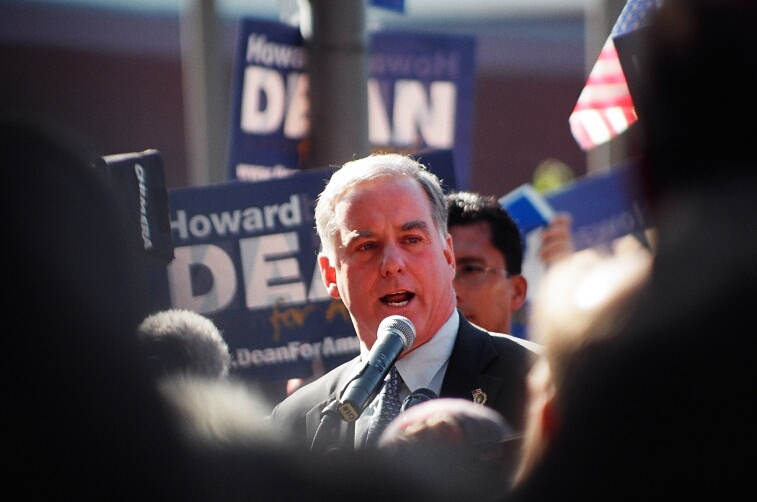by Caroline Sutton

“The Goliath of totalitarianism will be brought down by the David of the microchip.”
With these words spoken in 1989, just months before the fall of the Berlin Wall, former President Ronald Reagan captured a major sentiment of the moment. Many sensed that the fall of communism was imminent, and prevailing wisdom foretold that liberal democracies would soon become the global norm as the internet made people more connected and more able to speak for themselves. Digital technology would make centralized authorities of all types obsolete and would perfect societies all over the world.
Reagan was channeling a political ideology known as “techno-utopianism,” and this ideology would flourish in American society throughout the 1990s and into the early 2000s. While there were variations within the movement, it came to be defined by an anti-authoritarian attitude reminiscent of 1960s hippie counterculture, an understanding of social progress as a natural consequence of technological progress, and strong support of economic libertarianism. A key proponent of the movement was John Perry Barlow, who wrote “A Declaration of the Independence of Cyberspace” and believed the Internet was the realm of ultimate freedom. Through publications like the San Francisco-based Wired magazine, these ideas became a major force in the culture of Silicon Valley in the late 20th and early 21st century.
Since Silicon Valley is currently undergoing its own reckoning with the effects of technology on society, now is a prime opportunity to also question whether the faith in the partnership of digital technology and politics should be viewed as optimistically as it frequently is by campaign practitioners. A few months have now passed since the company Shadow Inc. received criticism for creating a rushed and faulty app for the Iowa Democratic Party, which broke down on caucus night and caused significant delays in reporting election results. People familiar with the app claim that it was put together in only two months and was never properly tested before its launch on caucus night. Perhaps worst of all, the technical difficulties led many to question whether the final election results would be accurate and therefore damaged Americans’ confidence in the integrity of their elections. One computer science professor at Georgetown University, Matt Blaze, said that any type of app that uses a cell phone network to deliver results is open to problems on both the app itself and the phones being used to run it. “The consensus among all experts who have been thinking about this seems to be unequivocal. Internet and mobile voting should not be used at this time in civil elections.” He added, “I think the most important rule of thumb in introducing technology into voting is to be extremely conservative.”
The incident, which is back in the news as Shadow Inc. attempts to rebrand itself as BlueLink, has also shone a spotlight on Tara McGowan, the head of Shadow’s parent group, Acronym. In the months before the Iowa caucuses, Acronym had been considered the “next big thing” in the digital space of the Democratic Party, garnering a flood of positive media coverage and large contributions from donors. McGowan has been called a “starry-eyed techno-utopian” for her insistence that societal failings can be corrected through innovation or a new app. Had the Iowa app episode not blown up so spectacularly, it would be natural to imagine McGowan as 2020’s rendition of Joe Trippi, the campaign strategist who brought techno-utopianism into the political mainstream.
Joe Trippi worked in Silicon Valley in the 1990s and was an avid techno-optimist, but he is perhaps best known as the campaign manager of the 2003-04 Howard Dean campaign. Suspicion of hierarchy and a tendency to pair technological progress with social progress were key beliefs within Dean’s organization, which eschewed traditional campaign methods for an emphasis on digital campaigning. Dean was the first candidate to use the Internet extensively. His team ran the first campaign blog, the first online volunteering organizing operation, and Dean was the first politician to widely collect small-dollar donations. Many even credit his primary run with launching the digital campaign industry. But do the techno-utopian assumptions upon which digital campaigning is based still hold true? Do these “starry-eyed” innovators deserve to keep their lauded position?
The idealism and authenticity of the Dean campaign
From the very beginning of the 2003-04 cycle, it was clear that Howard Dean, at the time a recently retired Governor of Vermont, would be running a new kind of campaign. An underdog candidate with little establishment support, he attracted a loyal grassroots following through his brash public persona and by taking on bolder policy positions than many of his rivals. Dean ran on a largely progressive platform marked by his opposition to the war in Iraq, his support for universal healthcare, and his desire to repeal the 2001 and 2003 tax cuts passed under the Bush administration.

While Dean was a novel candidate, it was his campaign manager, Joe Trippi, who pushed the idea that the Internet would force the political process itself to become more democratic. Before Dean’s candidacy, the Internet had been used to merely make traditional top-down campaigning cheaper and more convenient. For Trippi, however, the Internet was important because it armed citizens with knowledge about their governments and also provided them with the tools to shape their government to their preferences. In this sense, the Internet’s role went beyond technology and instead became representative of an ideology surrounding how governments should serve citizens. The anti-authoritarian attitude inherent to techno-utopianism was, in this case, channeled into letting supporters use online organizing to communicate with fellow citizens about their own reasons for supporting their candidate, rather than repeating talking points pushed on them by the campaign. Frequently, tactics like this were meant to make the democratic process—and thus government—more responsive to citizens. Campaigns in the age of the Internet, according to Trippi, should become catalysts for citizens to become more closely involved in democracy, rather than hierarchical organizations focused on controlling and disseminating a candidate’s message.
Dean’s supporters stepped up and made the decentralized philosophy of the campaign a reality. For example, through digital organizing platforms like Meetup.com, volunteers organized themselves, usually with no assistance from the campaign. They spontaneously formed large groups all over the country to discuss their interest in the candidate and to take actions like door-knocking to convince others to support him. Individual donors also funded the campaign through online, small-dollar donations meant to make the campaign and candidate accountable to the people rather than to wealthy donors.
Dean and Trippi’s promise that their campaign was run for and by supporters inspired people to invest their time in the campaign as well. They attracted talented workers from the corporate world, as well as technical workers out of Silicon Valley. Many of these supporters were willing to leave lucrative jobs and take a large pay cut, or even take no salary at all, to work for Dean. Several volunteers and staff were previously apolitical, and many claimed to be just as attracted to the community cropping up through the campaign as they were to any one policy position. “The thought that he’ll be president is just a side effect,” declared one organizer. “This campaign is about allowing people to come together and tell their life stories.” A collaborative, open-source work style was the norm for much of the staff and volunteers, meant to both drive innovation and reflect the anti-hierarchical ethos of the campaign.
There was a limit to the people’s power, however. Though Dean was once considered a frontrunner, his campaign quickly lost viability after a third place result in the Iowa caucus and the “Dean scream” ended his ability to run as a serious candidate. He would drop out of the primary race after a poor showing in Wisconsin and go on to endorse the eventual nominee, Senator John Kerry of Massachusetts. While Dean failed to win the nomination, the digital practices and digital optimism of his campaign had a significant impact on the political landscape. Many experts even believe that the innovations made through Dean for America helped Barack Obama win the presidency in 2008 and 2012.
Times have changed
A lot has changed in the digital political communication world since 2004. The capabilities that the Dean campaign developed in-house are now usually outsourced to private, for-profit firms. In light of this outsourcing, monetary interests regarding the development and implementation of digital campaign tactics have necessarily been substituted for some of the community-focused ideology and passion which fueled the Dean campaign. Howard Dean’s primary run was an authentic grassroots movement that used Internet tools to give supporters ownership of the campaign, whereas today, many practitioners use the Web to collect data and control messaging. “That’s centralized power, not decentralized power,” Zephyr Teachout, the Director of Internet Organizing for the Dean campaign told Politico. “That’s not what we meant to do. I was a true believer that we could change the way political campaigns operated.” Top-down digital techniques have not replaced grassroots campaigning, but, rather, the pervading norm is now a mix of top-down and grassroots—not the strictly peer-to-peer, decentralized digital campaign that Trippi and others envisioned. Finally, the assumption that more technical innovation will lead to social progress has been called into question, as developing digital techniques present threats for voter privacy and manipulation. If the business of digital campaigning has changed so dramatically, should we still put so much faith in the industry?
In addition to a move away from the ideological underpinnings of the Dean campaign, the digital innovations that came out of the 2003-04 primary run—social networking, do-it-yourself grassroots tools—were meant to work on campaigns, not to become part of the actual act of casting a ballot, like Shadow’s Iowa app was. When the stakes are so much higher, affecting not just one campaign but an entire state’s trust in the integrity of their election, the business involved must undergo more scrutiny. The leaders at Shadow likely had the best of intentions, but, at the level on which they were operating, good intentions and faith in the partnership of technology and politics are not enough; they are certainly no replacement for competence and experience.
The digital campaign industry is built upon an ideological basis which argues that the means for creating social change are found through technological innovation. It is not an enterprise set up to question whether a piece of technology is really necessary or if, in some cases, an attempt to innovate may actually do more harm than good. Experts agree that the Iowa caucus app was not needed—volunteers had called in caucus results via telephone for decades with little issue. If these digital firms are going to become further entwined with the election process, then they, along with the parties who hire them, must become more introspective and better able to recognize where they can and should contribute.
Caroline Sutton writes on political communication, technology, and public diplomacy. She currently resides in Wilmington, North Carolina and is a graduate of the MSc Program in Politics and Communication at the London School of Economics.

Leave a comment